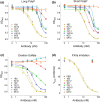Development of Coagulation Factor XII Antibodies for Inhibiting Vascular Device-Related Thrombosis
- PMID: 33868498
- PMCID: PMC8010086
- DOI: 10.1007/s12195-020-00657-6
Development of Coagulation Factor XII Antibodies for Inhibiting Vascular Device-Related Thrombosis
Abstract
Introduction: Vascular devices such as stents, hemodialyzers, and membrane oxygenators can activate blood coagulation and often require the use of systemic anticoagulants to selectively prevent intravascular thrombotic/embolic events or extracorporeal device failure. Coagulation factor (F)XII of the contact activation system has been shown to play an important role in initiating vascular device surface-initiated thrombus formation. As FXII is dispensable for hemostasis, targeting the contact activation system holds promise as a significantly safer strategy than traditional antithrombotics for preventing vascular device-associated thrombosis.
Objective: Generate and characterize anti-FXII monoclonal antibodies that inhibit FXII activation or activity.
Methods: Monoclonal antibodies against FXII were generated in FXII-deficient mice and evaluated for their binding and anticoagulant properties in purified and plasma systems, in whole blood flow-based assays, and in an in vivo non-human primate model of vascular device-initiated thrombus formation.
Results: A FXII antibody screen identified over 400 candidates, which were evaluated in binding studies and clotting assays. One non-inhibitor and six inhibitor antibodies were selected for characterization in functional assays. The most potent inhibitory antibody, 1B2, was found to prolong clotting times, inhibit fibrin generation on collagen under shear, and inhibit platelet deposition and fibrin formation in an extracorporeal membrane oxygenator deployed in a non-human primate.
Conclusion: Selective contact activation inhibitors hold potential as useful tools for research applications as well as safe and effective inhibitors of vascular device-related thrombosis.
Keywords: Contact activation; Hemostasis; Platelet.
© Biomedical Engineering Society 2020.
Figures









Similar articles
-
Antibody inhibition of contact factor XII reduces platelet deposition in a model of extracorporeal membrane oxygenator perfusion in nonhuman primates.Res Pract Thromb Haemost. 2020 Feb 11;4(2):205-216. doi: 10.1002/rth2.12309. eCollection 2020 Feb. Res Pract Thromb Haemost. 2020. PMID: 32110750 Free PMC article.
-
Targeting coagulation factor XII provides protection from pathological thrombosis in cerebral ischemia without interfering with hemostasis.J Exp Med. 2006 Mar 20;203(3):513-8. doi: 10.1084/jem.20052458. Epub 2006 Mar 13. J Exp Med. 2006. PMID: 16533887 Free PMC article.
-
Factor XII contact activation can be prevented by targeting 2 unique patches in its epidermal growth factor-like 1 domain with a nanobody.J Thromb Haemost. 2024 Sep;22(9):2562-2575. doi: 10.1016/j.jtha.2024.06.005. Epub 2024 Jun 17. J Thromb Haemost. 2024. PMID: 38897387
-
In vivo roles of factor XII.Blood. 2012 Nov 22;120(22):4296-303. doi: 10.1182/blood-2012-07-292094. Epub 2012 Sep 19. Blood. 2012. PMID: 22993391 Free PMC article. Review.
-
The factor XIIa blocking antibody 3F7: a safe anticoagulant with anti-inflammatory activities.Ann Transl Med. 2015 Oct;3(17):247. doi: 10.3978/j.issn.2305-5839.2015.09.07. Ann Transl Med. 2015. PMID: 26605293 Free PMC article. Review.
Cited by
-
Coming soon to a pharmacy near you? FXI and FXII inhibitors to prevent or treat thromboembolism.Hematology Am Soc Hematol Educ Program. 2022 Dec 9;2022(1):495-505. doi: 10.1182/hematology.2022000386. Hematology Am Soc Hematol Educ Program. 2022. PMID: 36485148 Free PMC article.
-
Factor XII Structure-Function Relationships.Semin Thromb Hemost. 2024 Oct;50(7):937-952. doi: 10.1055/s-0043-1769509. Epub 2023 Jun 5. Semin Thromb Hemost. 2024. PMID: 37276883 Review.
-
Coagulation and complement: Key innate defense participants in a seamless web.Front Immunol. 2022 Aug 9;13:918775. doi: 10.3389/fimmu.2022.918775. eCollection 2022. Front Immunol. 2022. PMID: 36016942 Free PMC article. Review.
-
Factor XII contributes to thrombotic complications and vaso-occlusion in sickle cell disease.Blood. 2023 Apr 13;141(15):1871-1883. doi: 10.1182/blood.2022017074. Blood. 2023. PMID: 36706361 Free PMC article.
-
The evolution of factor XI and the kallikrein-kinin system.Blood Adv. 2020 Dec 22;4(24):6135-6147. doi: 10.1182/bloodadvances.2020002456. Blood Adv. 2020. PMID: 33351111 Free PMC article.
References
-
- Cheng Q, Tucker EI, Pine MS, Sisler I, Matafonov A, Sun MF, White-Adams TC, Smith SA, Hanson SR, McCarty OJ, Renne T, Gruber A, Gailani D. A role for factor XIIa-mediated factor XI activation in thrombus formation in vivo. Blood. 2010;116:3981–3989. doi: 10.1182/blood-2010-02-270918. - DOI - PMC - PubMed
-
- Crosby JR, Marzec U, Revenko AS, Zhao C, Gao D, Matafonov A, Gailani D, MacLeod AR, Tucker EI, Gruber A, Hanson SR, Monia BP. Antithrombotic effect of antisense factor XI oligonucleotide treatment in primates. Arterioscler. Thromb. Vasc. Biol. 2013;33:1670–1678. doi: 10.1161/ATVBAHA.113.301282. - DOI - PMC - PubMed
Grants and funding
LinkOut - more resources
Full Text Sources
Research Materials

